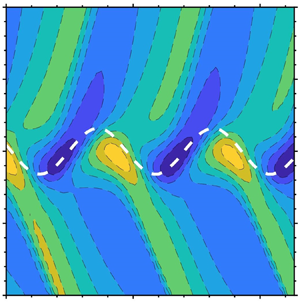Article contents
Dynamics of the jet wiping process via integral models
Published online by Cambridge University Press: 01 February 2021
Abstract

The jet wiping process is a cost-effective coating technique that uses impinging gas jets to control the thickness of a liquid layer dragged along a moving strip. This process is fundamental in various coating industries (mainly in hot-dip galvanizing) and is characterized by an unstable interaction between the gas jet and the liquid film that results in wavy final coating films. To understand the dynamics of the wave formation, we extend classic laminar boundary layer models for falling films to the jet wiping problem, including the self-similar integral boundary layer and the weighted integral boundary layer models. Moreover, we propose a transition and turbulence model to explore modelling extensions to larger Reynolds numbers and to analyse the impact of the modelling strategy on the liquid film dynamics. The validity of the long-wave formulation was first analysed on a simpler problem, consisting of a liquid film falling over an upward-moving wall, using volume of fluid simulations. This validation proved the robustness of the integral formulation in conditions that are well outside their theoretical limits of validity. Finally, the three models were used to study the response of the liquid coat to harmonic and non-harmonic oscillations and pulsations in the impinging jet. The impact of these disturbances on the average coating thickness and wave amplitude is analysed, and the range of dimensionless frequencies yielding maximum disturbance amplification is presented.
- Type
- JFM Papers
- Information
- Copyright
- © The Author(s), 2021. Published by Cambridge University Press
References
REFERENCES
Mendez et al. supplementary movie 1
This figure shows the dimensionless film thickness of coating along a substrate moving upward during an unsteady jet wiping process. The impinging jet oscillates producing a time-dependent pressure gradient profile (blue line dotted, wrt bottom axis in Skhadov-like units). The film thickness evolution (top axis) is computed using three integral models presented in this work, namely the IBL (dashed black line), WIBL (continuous blue line), and TTBL (dotted red line).
Mendez et al. supplementary movie 2
Animation of Figure 15, Bottom. This figure shows the dimensionless film thickness of coating along a substrate moving upward during an unsteady jet wiping process. The impinging jet oscillates producing a time-dependent pressure gradient profile (blue line dotted, wrt bottom axis in Skhadov-like units). The film thickness evolution (top axis) is computed using three integral models presented in this work, namely the IBL (dashed black line), WIBL (continuous blue line), and TTBL (dotted red line).
- 12
- Cited by



